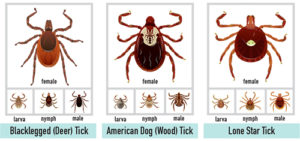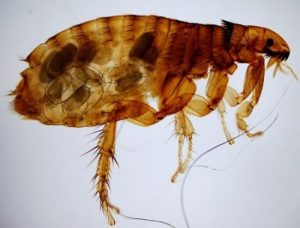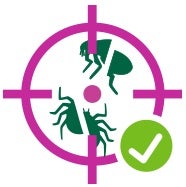Ticks and fleas are a growing concern in Southern Ontario and for its residing animals. Ticks and fleas are both classified as ectoparasites, which means that they live outside of the body. They seek warmth within the fur of animals and feed on their blood. Owners should regularly check their pets for ticks and fleas, especially in the warmer months when it is above 4 degrees Celsius (when ticks and fleas are most active), and speak with their veterinarian about a parasite prevention plan. Outlined below is some basic information surrounding ticks and fleas. For more information, please contact us and one of our friendly staff will be happy to assist you!
TICKS
Ticks are among the most efficient of disease carriers, they attach firmly when sucking blood, feed slowly and tend to go unnoticed on pets for a considerable amount of time. Ticks are not insects and are closely related to the mite and spider family as they have 8 legs instead of 6.
Dogs specifically are very susceptible to tick bites and contracting tick-borne diseases. It is very important to consider all preventative measures when it comes to keeping ticks at bay – vaccines are not available to prevent the majority of transmissible diseases from ticks, and they don’t prevent ticks from entering your home. For many different reasons, it’s very important to use a tick and flea prevention product on your dog whenever ticks are active, which occurs whenever the weather is above 4 degrees Celsius. Tick and flea season typically runs from March until November, but with our varying temperatures the season may begin and/or extend longer than this time period.
At Risk Population:
- Ticks are rarely found on cats, they usually prefer dogs as their final host.
- Dogs who walk through wooded, grassy or meadow areas are at higher risk of contraction.
Ticks in Ontario
The most common tick species we see in Ontario:
- Ixodes scapularis (Deer/Black Legged Tick)
- Can transmit Lyme disease and Anaplasmosis
- Signs of Lyme disease include: lethargy, inappetence, lameness, kidney failure and nervous system side effects among others.
- Signs of Anaplasmosis: Lethargy, joint pain, ataxia, fever, inappetance, vomiting, diarrhea among others.
- Dermacentor variabilis (American Dog Tick/Wood Tick)
- Can transmit Rocky Mountain Spotted Fever
- Signs of Rocky Mountain Spotted Fever: Fever, lethargy, joint pain, poor appetite, vomiting, diarrhea among others.

Why are ticks a concern?
- Ticks suck blood – females feed by inserting their mouth parts into the host. Untreated tick infestations may lead to anemia, especially in young animals.
- The saliva of some female ticks is toxic. Prolonged tick attachment can lead to tick paralysis. Signs of tick paralysis include initial weakness/unsteadiness in the hind end that progresses to full body paralysis.
- Ticks are capable of transmitting diseases. Ticks are required to be attached to the host for at least 24 hours prior to being capable of transmitting disease, although often go unnoticed much longer than this. The Deer/Black Legged Tick is the tick that is responsible for transmitting Lyme disease. This disease not only affects our pets but, it can affect humans as well. Your pet can be tested for tick transmitted diseases by performing a blood test each year in the spring. We routinely screen for Heartworm and 3 different tick borne diseases: Lyme disease, Ehrlichia and Anaplasma. A few drops of blood are pulled from your dog and the test is run in-house within minutes – this test is typically recommended to be done around late April-June.

You found a tick on your pet. Now what?
If you find a tick on your dog or cat, it should be removed promptly and properly. Using tweezers, grasp the tick as close to the skin as possible and pull straight up. If you are unsure if all of the tick was removed, you should have your pet examined by your veterinarian. Ticks are very difficult to kill if the animal is not in a tick preventative product; flushing them down the toilet, stepping on them or throwing them in the garbage is unlikely to be sufficient – it is recommended to place them in isopropyl alcohol to effectively kill them and then bring them to your veterinarian for identification and to discuss risk factors. The tick species and level of engorgement can help to identify risk of disease transmission. A blood test should also be performed 4-6 weeks after the initial bite to ensure that the tick has not transmitted a disease while attached, and then a preventative plan should be discussed with your veterinarian.
Even if your pet only goes outside in the backyard to go to the bathroom, they are still at risk of tick attachment. All pets should be checked regularly after they go outside and all owners should speak with their veterinarian about a parasite prevention plan for their pets.
Having your pet on a tick/flea preventative veterinary product is a great way to prevent tick/flea infestations and decrease the risk of disease transmission before it occurs! Tick and flea preventative products kill these awful pests prior to them being able to transmit disease, with topical products having an additional benefit of also acting as an insect repellent. We offer both oral and topical preventative products, please give us a call today and we would be happy to discuss which treatment plan is best for your pet!
FLEAS
Fleas will use any warm blooded creature as a host, they are not very picky and can multiply very rapidly, quickly making them a nuisance. Fleas are 6 legged insects that affect both dogs and cats. There are 2 common species of fleas in Southern Ontario, but the most common species seen during infestation is Ctenocephalides felis. The most common indication of fleas on a pet is the fecal debris left behind by adult fleas (flea dirt) which is digested blood, this is commonly seen within the coat of an affected animal. Another common symptom is intense itching that may lead to moist, raw and red areas of hair loss that can often lead to secondary bacterial infection if left untreated.

A flea under a microscope
At Risk Population:
Fleas are found on both dogs and cats of all ages.
Why are fleas a concern?
- Flea infestation can result in flea bite dermatitis (FAD). Flea saliva is antigenic and irritating, which can lead to hypersensitivity and pruritus (itching).
- After one blood meal, the adult female will begin to lay eggs – which can accumulate to about 50 a day. These eggs are deposited onto the fur of the host, because they are not sticky they usually fall off of the animal onto other surfaces such as the carpet, bedding or furniture.
- An adult flea can emerge from its cocoon as early as 8-9 days or it can stay in the cocoon for a year or longer – waiting for the right time to emerge. This is a very unique feature of fleas, they can control when they will emerge, based on surrounding features such as warm temperatures, high humidity and vibrations (ex. Cat walking – indicating a blood meal is nearby)
- Fleas are blood sucking parasites. Untreated flea infestations may lead to anemia, especially in young animals.
- Fleas are the intermediate host for Dipylidium caninum (tapeworms). This means that fleas are capable of transmitting tapeworms to your pet.
- Fleas will lay eggs in your house where it is warm, so they will thrive year round. They prefer to live on an animal but mostly live in the environment.

Tapeworm
You found fleas on your pet. Now what?
If you found fleas on your dog or cat, you should schedule an appointment with your veterinarian. Your pet will have to be treated for at least three months using a topical or oral parasite product that treats fleas and tapeworms. Since fleas and their eggs will be in the environment, you must treat your house as well. Carpets and furniture throughout your home should be vacuumed and blankets/bedding should be washed. You can also buy flea sprays that kill fleas in the environment. All owners should also speak with their veterinarian about a parasite prevention plan.
Best Prevention for Ticks and Fleas:
- Application of the proper tick and flea preventative prescription (oral and topical form if available) throughout the duration of tick and flea season (whenever the weather is above 4 degrees Celsius!) Please discuss the best treatment plan with your veterinarian today.
- Over the counter flea and tick repellant medications/solutions (topical, collars, sprays) are also available from pet stores but are not highly recommended by veterinarians. These products often do not require the amount of scientific research necessary to approve them and make sure they are safe and effective. Along with this, some of the ingredients used may be toxic to pets.
- Avoiding wooded and high grass areas where ticks usually linger
- Frequently checking your pet for fleas and ticks after a trip outdoors
- Completing an annual heartworm and tick borne disease test in the spring (April-June) for all dogs over 6 months of age to make sure an infection has not been transmitted from the previous season

Feel free to give us a call today (519-893-8937) to schedule your parasite prevention discussion and your dog’s annual heartworm and tick borne disease test!


